Day 2 of a three day long weekend of Spring Migration tours on the North Norfolk coast. It was forecast to be cloudy in the morning with only a 10% chance of rain, but the weather had not looked at the forecast and it was raining early on. Thankfully it had cleared through by the time we got out. It was still rather grey and cloudy this morning, and cool in the light NE wind, but then it all changed in the afternoon and we had blue skies and sunshine by the end of the afternoon. That’s more like it!
It was still raining as we drove west along the coast road, but it had stopped by the time we arrived at Choseley. There was no sign of the five Dotterel in the field where they had been for the last few days when we got there, and apparently they had not been seen since early morning. A Corn Bunting was singing in the hedge behind us, and perched up nicely in the top, so we could get it in the scope. From time to time over the next hour, we could hear its song – sounding not entirely unlike the bunch of jangling keys it is supposed to resemble.
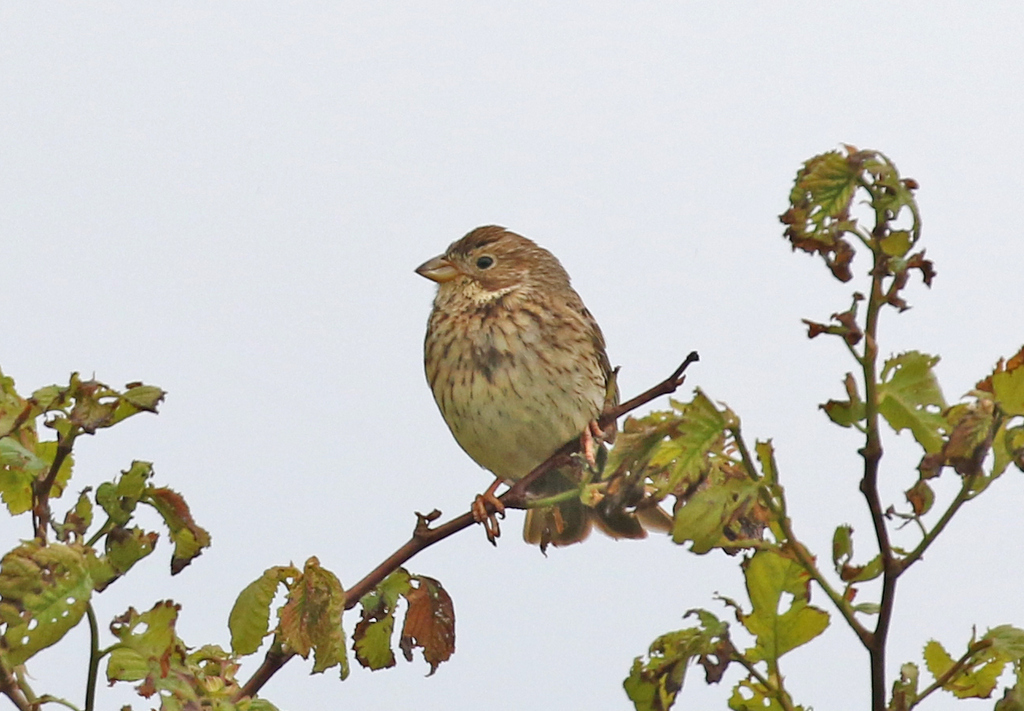
While we were watching the Corn Bunting, we heard Dotterel calling and looked up to see a small tight flock flying in from the east. There were clearly more than the five which had been here for the last few days, and when they eventually landed we could see there were now ten Dotterel accompanied by a single Golden Plover. They landed at the top of the field, stood there for a short time looking round, then started walking quickly down the field towards us.
We had a great view of the Dotterel in the scope, with a mixture of brighter females and duller males, the other way round in this species from many other birds as the males undertake most of the chick-rearing duties. They would take several quick steps and then freeze, at which point they were remarkably hard to see against the bare earth and stones of the field. We stood and watched them for a while, as they gradually came closer. We had a nice view of the Golden Plover too with them, another smart ‘northern’ male with a black face and belly, like the one we had seen yesterday.
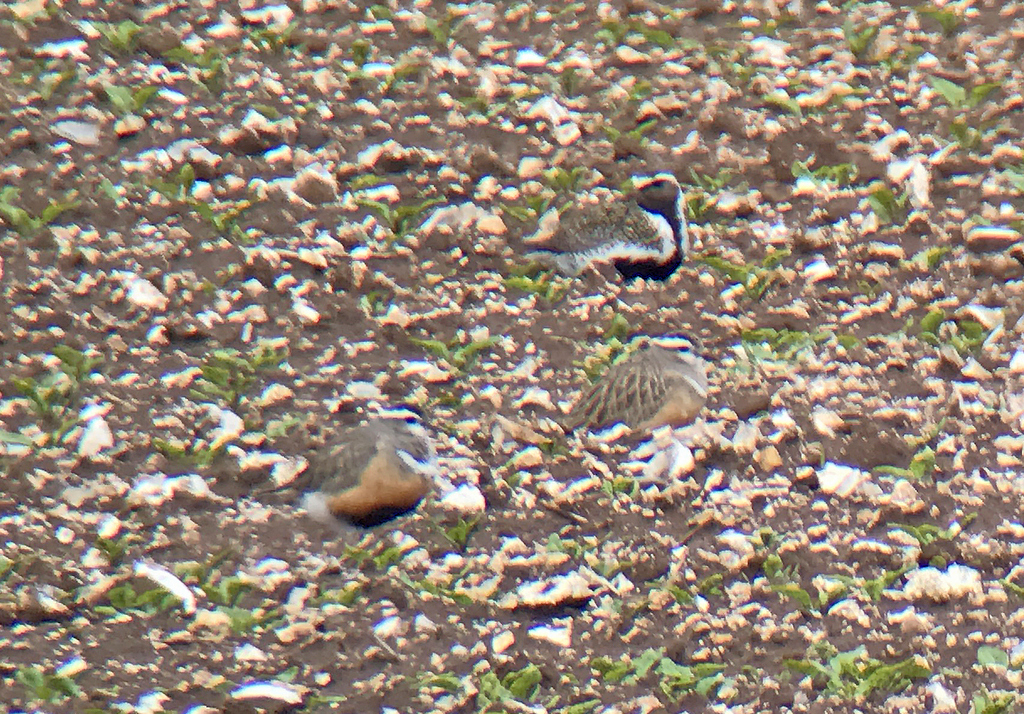
The Dotterel stopped to preen half way down the field and the next time we looked back at them there were now sixteen. We didn’t see the other six fly in so we were not sure if they had walked across the field to join the bigger group. Either way, there were obviously a lot of fresh arrivals this morning. A small number of Dotterel breed in Scotland, high in the mountains, but these are Scandinavian birds on their way north from their wintering grounds in North Africa. They stop off at traditional sites each spring and this is one of their favourite fields.
There were lots of Brown Hares in the fields here too, and we watched several pairs chasing each other round. We were even treated to a brief bout of boxing from two of them.
After watching the Dotterel for a while, we moved on, down to Holme. It was still rather grey but at least it wasn’t raining now and there were still warblers singing. We could hear a Blackcap and several Common Whitethroats and we stopped to watch a Sedge Warbler performing in the top of a tall hawthorn. A Cuckoo was singing away in the distance, and we realised we could see it perched on the top of a dead tree off in the dunes.
From up on the seawall, we could see a grey-brown Lesser Whitethroat feeding low in the buckthorn by the entrance track. As we walked down to the old paddocks, we could hear a Cuckoo closer and looked across to see a pair out over the saltmarsh on the top of the dunes behind the beach. Through the scope, we could see them being mobbed by a couple of Meadow Pipits, worried about the safety of their nests.
Looking over to the bushes in the paddocks behind us, we spotted a smart male Common Redstart which flew out and landed on a sandy area in the middle of the short grass. Unfortunately it didn’t stop long and flew straight back into the bushes before everyone could get onto it. Some walkers came along the path the other way at that point and it was probably no surprise that when we walked further up to try to find it, there was no sign. We figured we would leave it in peace for a bit and try again on the way back.
As we carried on along the path, a lovely pink male Bullfinch appeared briefly in the bushes ahead of us calling softly, before flying across and disappeared back into the paddocks. There were three Cuckoos now, all together out across the saltmarsh, two males chasing each other and round after a female. A steady passage of Swallows passed west overhead in twos and threes, and we could see a single Common Swift distantly out over the grazing marshes.
When we walked back the Redstart had duly reappeared, just as we had hoped. It was perched on the fence at first, but then dropped down to the ground and flew back up to a large hawthorn bush. It was chased by a Robin, but thankfully settled, and we had a great view through the scope of it perched in the bush. A stunning bird!
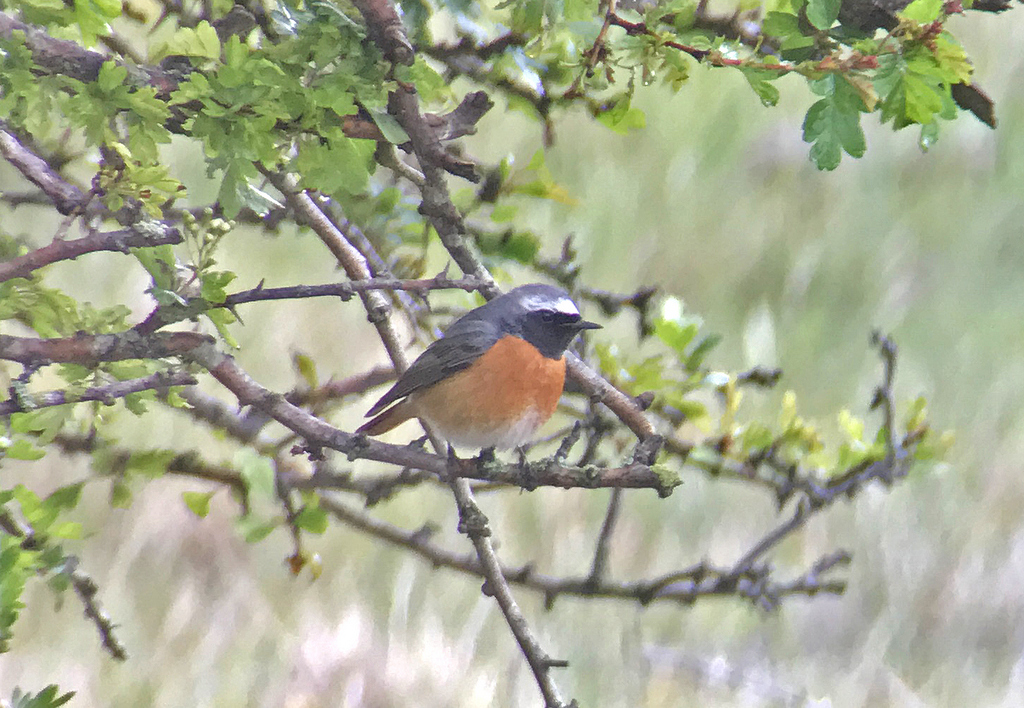
While Common Redstarts breed in the UK, this was probably another migrant on its way further north, most likely to Scandinavia. Eventually some more people came along the path behind us, and the Redstart flew back across the paddocks and disappeared into the bushes again.
Past where we had parked, we continued on east through the dunes. There were lots of Meadow Pipits and Linnets and plenty of Common Whitethroats singing. A couple of Marsh Harriers were quartering over the grazing marshes inland and two Common Buzzards were perched on some gates. We were hoping to find two Ring Ouzels which had been seen in the dunes here earlier, but there was no sign. There were lots of people walking about now, lots of disturbance, so they had probably gone somewhere quieter. As we walked back, a Cuckoo perched up nicely in a bush singing, so we could get a good look at it in the scope.
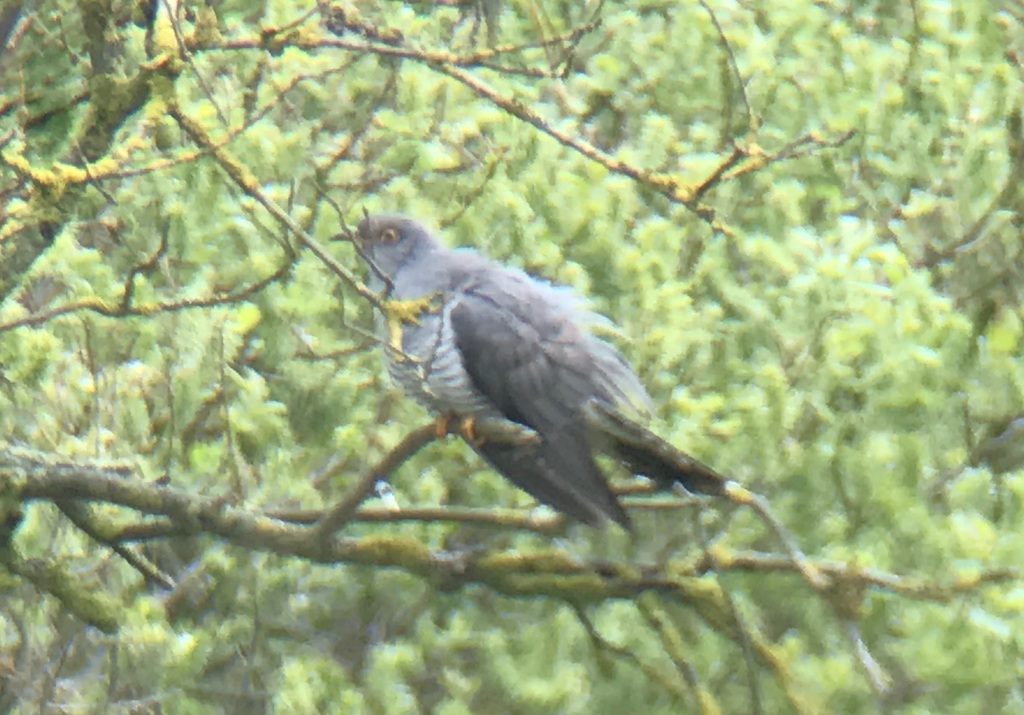
It was starting to brighten up now, so we made our way round to Titchwell for lunch. We could even make use of the picnic tables by the Visitor Centre. There had been three Black Terns out over the reedbed pool this morning, so after lunch we walked straight out to try to see them. It was bright and sunny now, and we had thought they might move off as the weather cleared, but thankfully they were still there.
We stopped to watch the Black Terns, hawking over the pool. They are very smart birds in breeding plumage, grey above with a jet black head and body. They used to breed in the UK, up until the middle of the 19th century, before widespread draining of marshes probably wiped them out. Now they breed from the Netherlands eastwards from here, wintering in Africa. These had probably drifted across to the UK on the easterly winds and been brought down by the rain this morning.
We could hear Bearded Tits calling around the pools below the bank too – we didn’t know which way to look. We saw one fly in and land at the base of the reeds at the back of one of the pools, a smart male with a powder blue-grey head and black moustache. It was immediately followed by a recently fledged juvenile, tawny-coloured and with a short, only partly-grown tail. We watched the two of them working their way round the edge of the pools, low down in the reeds. The male was looking for food and would periodically stop to feed the youngster. Great to watch and fantastic views of this often very secretive species.
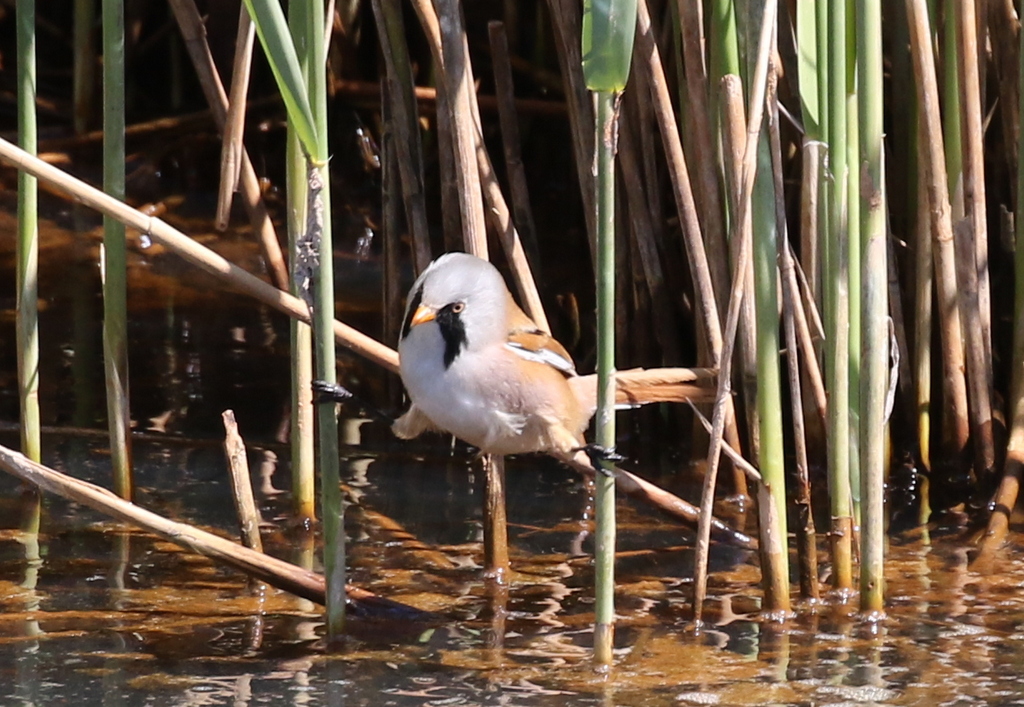
We stood and watched the Bearded Tits and Black Terns for a while, and eventually had to tear ourselves away and move on to explore the rest of the reserve. As we continued on towards the Freshmarsh, we could see a Grey Plover on Lavender Pool, mostly in breeding plumage with a black face and belly. We stopped to admire a pair of Gadwall on the near corner of the Freshmarsh. They were closer enough that we could get a really good look at the intricate plumage of the drake. Not just a boring grey duck after all!
There were several Common Terns back on the Freshmarsh now, hopefully returned to breed. One landed on the measuring post in front of Island Hide, while another flew round just above our heads calling. There were more on the closest island in amongst the gulls.
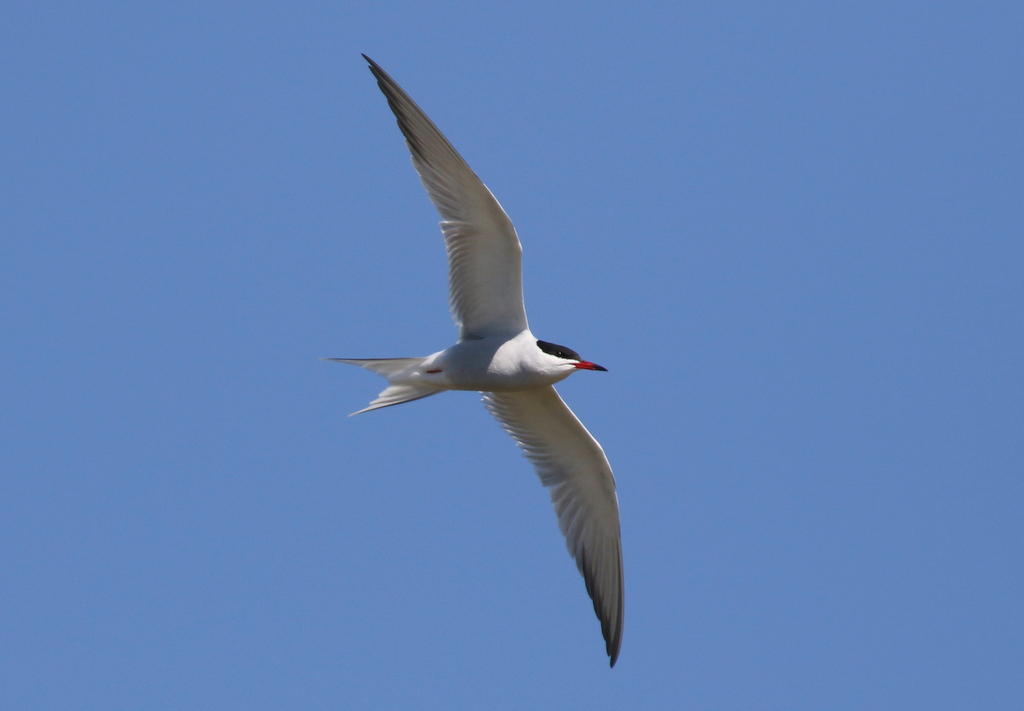
The Freshmarsh has been rather taken over by gulls these days. There were lots of Black-headed Gulls covering most of the islands, but we did manage to find a few Sandwich Terns still in with them, further back towards the fenced off island. There were not many different waders on here today. Aside from plenty of Avocets, a Whimbrel dropped in briefly but flew straight out again, chased by one of the Oystercatchers.
There are still a few ducks – mostly Shelduck and Shoveler, plus a few lingering Teal – but the majority which spent the winter here have left for their breeding grounds further north and east. There are still quite a few lingering Brent Geese, which flew in and out from feeding out on the saltmarsh. They should be leaving soon too, on their way back to Siberia for the summer.

We walked round to Parrinder Hide next for a closer look at the gulls. From here, it was easier to pick out all the Mediterranean Gulls in the large colony with all the nesting Black-headed Gulls which have taken over ‘Avocet Island’ (perhaps it should be renamed ‘Gull Island’?). We had a good look at a smart adult Mediterranean Gull through the scope, admiring its bright red bill, jet black hood with white eyelids and pure white wingtips. We had a much closer view of the one remaining Sandwich Tern on the island from here too – getting a better look at its yellow-tipped black bill and shaggy black crest.

We had a quick look in the other side of Parrinder Hide, out over Volunteer Marsh. There were several more Grey Plovers, including one or two very smart black and white males in full breeding plumage now. There were a few Curlew too. A single Whimbrel was feeding in the vegetation on the edge of the reeds in the middle, smaller, darker, with a shorter bill, and a pale central crown stripe. We had a particularly good comparison with one of the Curlew which walked across in front of it at one point.
Continuing on out towards the beach, we stopped at the now non-tidal ‘Tidal Pools’. There were still a few waders roosting on the island in the middle. A little group of Turnstones included several birds with more chestnut in their upperparts and white faces now, moulting into breeding plumage. A single Bar-tailed Godwit was asleep on the front edge, but we could see its barred tail, as well as its streaked upperparts, and three black-bellied summer Dunlin were nearby.
Out at the beach, the tide was still not fully out and the mussel beds were only partly exposed. There were a few Oystercatchers feeding where the mussels were already poking out above the water, and several smaller waders with them. They were Sanderling, most already moulting into darker breeding plumage, with just one or two still in their silvery grey winter attire.
There were a few more Bar-tailed Godwits along the beach further to the west, and we could now see their slightly upturned bills. A few distant Sandwich Terns were flying back and forth offshore, but otherwise the sea itself looked quite quiet. It was lovely out on the beach, but we had more to do yet so it was time to start walking back.
Back at the reedbed pool, the three Black Terns were still hawking up and down over the water. They had been mostly keeping low, but now one started to fly higher up. It was chasing a dragonfly and we watched it twisting and turning, trying to keep up with it, an epic duel. The tern eventually prevailed – looking at the photos afterwards we could see that it had caught a Hairy Dragonfly, the first we have seen this year!

When we asked in the Visitor Centre earlier, we were told that the Turtle Doves had not been seen this morning, but now someone let us know they had been seen again this afternoon, so we walked straight round to the Tank Road to try to see them. When we got there, we found they had apparently been scared off by a stoat about half an hour earlier.
We thought we would have a quick look at Patsy’s Reedbed instead, but just as we arrived at the screen, one of the group who had lingered behind came up to say he could hear a Turtle Dove which had started purring back behind us. We walked straight back, and could hear it and, with a bit of triangulation, we worked out where it was. But it was very deep in the bushes and we could just see some movement behind the leaves. Then suddenly it flew out and landed on a dead branch on the front of the bush. We all had a great view of it through the scope, before it disappeared back in again as quickly as it had appeared.
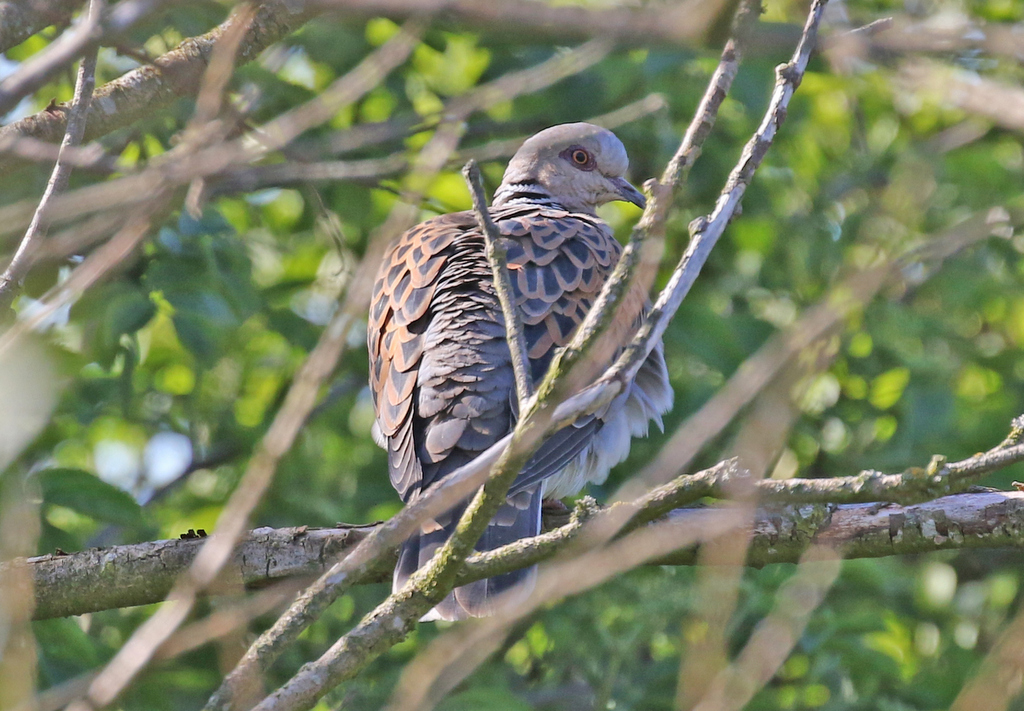
The Turtle Dove population in the UK has crashed and it is very possible we could lose this beautiful bird as a breeding species in the next few years. Emergency measures are called for and it is now necessary to provide supplementary seed for them, as they are doing at Titchwell. Hopefully they might stay to breed here again this year. It really is a privilege to see them and hear them purring, while we still can.
When the Turtle Dove disappeared, we went back over to Patsy’s. There were three smart male Red-crested Pochards out on the water, striking birds with their orange punk haircuts and bright coral red bills. A couple of Marsh Harriers were flying round over the reeds beyond.
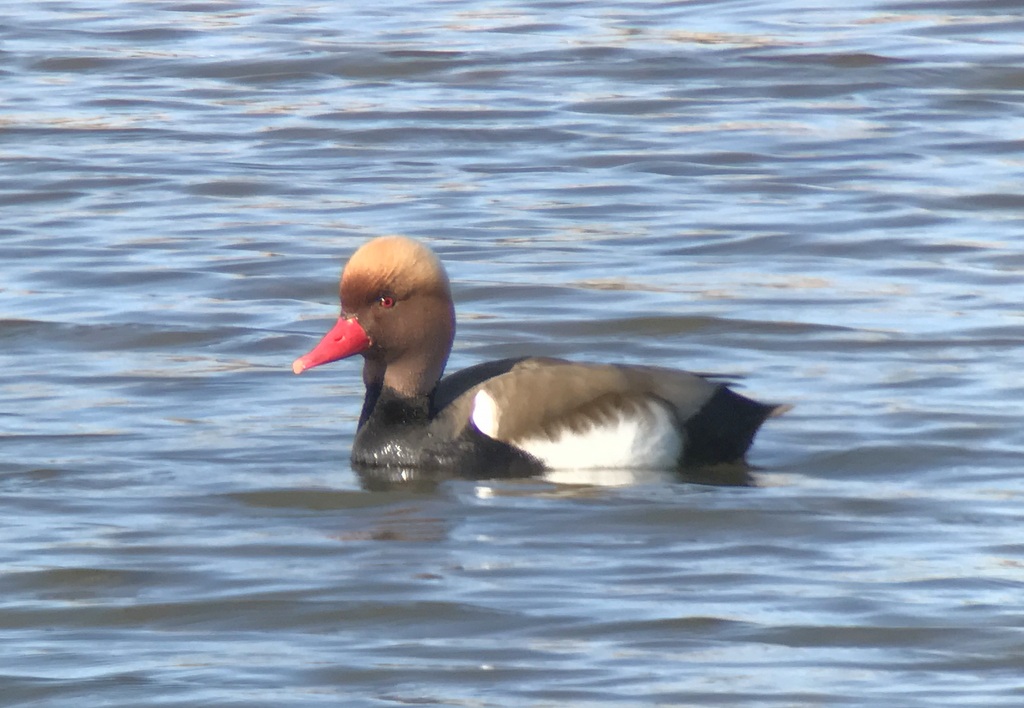
It was a lovely afternoon now, but unfortunately it was time to call it a day. We were still not quite finished and as we walked back along Fen Trail, we spotted a Water Vole just below the boardwalk. It was obviously very used to people, as it seemed completely unconcerned by us standing just a few feet from it, as it stood there munching on a piece of reed.

It was a nice finish to the day which kept on giving. Then it really was time to get back.
















